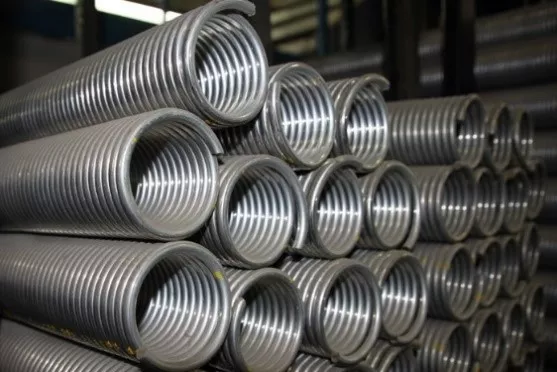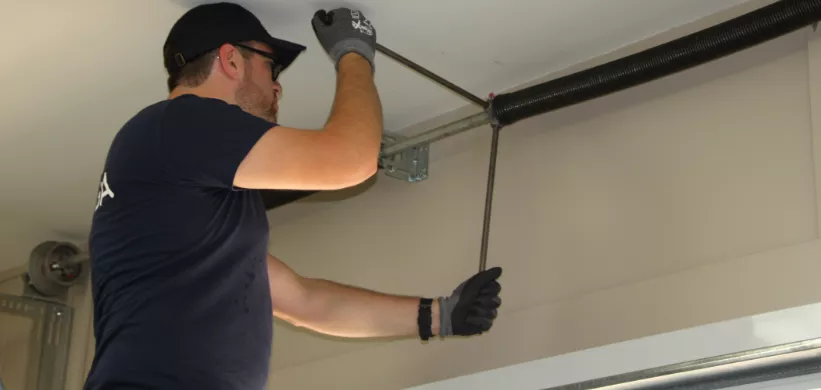It’s safe to say that it’s common knowledge that garage doors have springs involved in the mechanisms that make them function. What kind of springs those are is much less commonly known.
The springs that are part of the garage door work in a system that helps to keep the door in balance. A balanced garage door makes for one that is quiet, easy to open and close, and safe to operate. In this article, the focus is on torsion springs because they are better at making the garage door function more quietly, easily and safely.

Let’s Start at the Beginning: What Are Torsion Springs?
Torsion springs are tightly wound coils that work by producing mechanical energy through a twisting motion. That energy can be transferred to other parts of the system that the spring is working within to create movement. In the case of the garage door, the energy is used to lift the door up and lower it back down.
A Comparison Between Springs
Torsion springs aren’t the only type that can be used in a garage door system. There are actually two types of springs. They are torsion springs and extension springs. So, what’s the difference?
Extension springs are installed differently. They work by being placed above the tracks that run at the top of your garage. There are two of them installed, one above each track. When the door is being opened, each spring engages and starts working on its own. Because they work separately, you might find the door seems to jerk or shake sometimes. This is because the springs don’t wear the same so the amount of energy they produce may be different. Also, your door could be in need of adjustment from side‑to‑side.
Torsion springs are fitted just above the top of the garage door. There will be either one or two springs used. Typically, a single garage door will have one torsion spring and double garage doors will have two. The way torsion springs are installed is much different than extension springs. There is a housing that the spring is inserted into. The housing is secured with an anchor plate. The anchor plate is situated so that all of the weight of the garage door is balanced in the center. It makes the door able to operate more smoothly.
Torsion Is the Way to Go
Torsion springs are the more popular of the two. The reason is that they work in a way that makes the garage door function better, stay quieter and operate in a safer manner.
These springs function better because of where they transfer the door’s weight. Everything is balanced to the middle of the door rather than the sides where each track is located. You won’t have the jerking from side‑to‑side that you get from the use of extension spring systems.
Torsion springs make the door operate with less noise because the springs aren’t attached near the tracks. There’s less vibration and shaking since the spring is mounted to the solid wall with an anchor plate.
Finally, torsion springs are much safer to use than extension springs are. They are attached to the wall after being placed inside a shaft that has an anchor plate. In the event that a spring should break, any pieces will be caught inside the housing. This ensures that you won’t have damage to anything that the spring could have fallen on.
Torsion Spring System Functioning
Obviously, the torsion spring works within a system. There are other pieces to this puzzle. Here are the components that make up the torsion spring system:
- Torsion spring – the coil that creates the energy to lift the weight of the garage door
- Spring shaft – the housing that the spring is inserted into for anchoring to the wall
- Lifting cable – the cable that runs from the top of the door to the bottom that does the pulling
- Grooved drum – the mechanism that the cable is wound around for lifting or lowering the door
- Bracket – used to secure the cable to the bottom part of the door
When you push the button to open your garage door, the torsion spring starts to relax inside the shaft. The grooved drum turns, allowing the lifting cable to do its job and lift the door because it’s attached to the bottom of the door with the bracket. All of the pieces work together—bottom bracket + lifting cable + drum + shaft + spring.
The Life Span of a Torsion Spring
Many people want to know how long a torsion spring will last for their garage doors. The average amount of use you can expect is about 10,000 up and down cycles. If you do the math on that, assuming a scenario of leaving for work in the morning and then coming home at night, you’ll see that the springs should be good for up to seven years.
You can increase the life span of your torsion springs by doing a little maintenance on them. Maintenance typically just means keeping a schedule for regular lubricating of the metal parts. Since the springs are made of metal, they are subject to rust and corrosion. You can slow down that process by using lubricant.
You’ll also find that there are torsion springs that are fully galvanized, but that most have only about 35% of zinc for galvanization. Those who are in areas that have a lot of humidity will want to go with torsion springs that are fully galvanized to prevent rust.
Testing Your Torsion Spring Performance
You can easily test your torsion spring system to see if it is working the way that it should. It’s not a bad idea to do this test from time to time to make sure your garage door stays in good working condition.
All you need to do is disengage the automatic opener. Then try opening the garage door manually. It should be easy for you to do, and you shouldn’t feel like the door weighs more than 10 lbs. (5 kg). If the door is heavy and you feel like you have to really exert yourself to get it open, then your torsion springs might need to be looked at or replaced.
Normal Weight of a Garage Door
Just so you have a reference point, let’s look at how much a garage door actually weighs. Typically, you have either a single door – 9 x 7 ft., or a double door – 16 x 7 ft. You can also have an insulated or non‑insulated door, different thicknesses, and windows or no windows.
Here’s a breakdown:
-
For a 1 ¾"-thick steel door, insulated with polyurethane foam: about 2 lb. per square foot:
- Single—around 150 to 160 lb. (68 to 73 kg)
- Double—around 280 to 295 lb. (127 to 135 kg)
-
For a 2"-thick steel door, non-insulated: about 1 ½ lb. per square foot:
- Single—around 125 to 130 lb. (57 to 59 kg)
- Double—around 280 to 295 lb. (102 to 107 kg)
If there are windows to account for, you can add 2 ½ to 3 lbs. for each window.
Leave Repairs to the Experts
If there is ever a time when you need a repair made to a torsion spring, or you need one replaced, don’t try to do it yourself. It’s best that you employ the services of an expert to help you. If you’re anywhere close to Leamington or Windsor, then call us now at 1‑866‑534‑1373. We are garage door specialists and can repair these parts safely. You can also get a quotation by email to get things headed in the right direction.



Add new comment